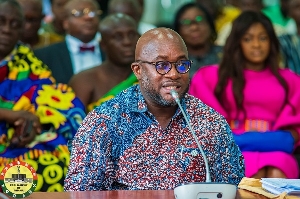Opinions of Friday, 28 April 2023
Columnist: Kwabena Adu Koranteng
Need to develop new strategies to fight piracy in the Gulf of Guinea
It seems the fight against Piracy by member countries on the Gulf of Guinea is not yielding the desired results, a situation that is making stakeholders worried as vessels and merchants continue to lose and trade suffers. Piracy continuous to be a major threat to shipping in the Gulf of Guinea.
So the question is what should be done to curb the increasing rate of piracy on the Gulf of Guinea?.
Yes we know that cooperation among member countries and their joint Military operations is key and that is what member countries have been doing for many years. Yes they have achieved some level of good or positive results and will continue to achieve more good results but that wouldn’t be enough to end piracy.
This week, the President of Ghana, Nana Addo Dankwa Akufo Addo, at an extra ordinary conference of Heads of States of the Gulf of Guinea Commission in Accra expressed worry that much is not being done to curb the situation.
President Nana Addo Dankwa Akufo-Addo is urging countries along the coast to adopt some strategies to fight piracy. President Akufo-Addo says the increasing spate of piracy and oil theft must be addressed.
Opening the Extra Ordinary Conference of Heads of States of the Gulf of Guinea Commission at the Jubilee House, President Akufo-Addo who is Chairman of the Commission charged African leaders to ensure that peace and security are strengthened in the fight against maritime-related crimes in the region.
The President said, “Excellencies I have taken up the opportunity to discuss two important issues to our region. First is the issue of finding means of making the region safe and secure. It is important that we have some serious discussion on these items in order to come up with strategies geared towards strengthening peace and security in winning the fight against maritime-related crimes in the region, such as piracy, illegal unreported and, unregulated fishing, arms trafficking, pollution of the environment, smuggling, fuel and crude oil theft.”
So back to the question. What are the strategies needed to curb and end piracy on the Gulf of Guinea?
The answer is that aside the military capabilities, there is a need for heavy investment in technology to support with patrolling and detecting pirate activities.
Artificial Intelligence, AI is one of the efficient technologies that can be used to enhance maritime safety, optimize business operations and process, and aid in voyage planning and vessel maintenance. AI allows new sense-making possibilities by quick generating insights through deep analysis of data and timely relay of critical information to the right people to facilitate decision-making for the best outcomes.
The use of AI-based systems to create fully automated piracy alerts enables seafarers to react faster, potentially saving lives. One of AI’s classifications is behavioral analysis to identify and recognize the possible patterns of suspicious movements of pirates based on past incidents and aggregate information. So I believe that when the Armies of the various member countries on the Gulf of Guinea are equipped and trained to operate these AI technologies alongside defense cooperation and operational efficiency, they should be able to curb piracy on the sub-continent.
According to Carlota Ahrens Teixeira and Jaime Nogueira Pinto, over the last 15 years, the region has also become one of the world’s hotspots for maritime piracy, overtaking the Gulf of Aden and the Horn of Africa, where Somali pirates operated. But as the situation improved on the east coast, a shift occurred and piracy in the Gulf of Guinea increased rapidly. Armed attacks, vessel boarding and hijacking, kidnappings and assassination of crew members became increasingly frequent.
In 2020, out of the 135 maritime kidnappings worldwide, 130 took place in the Gulf of Guinea, the highest number ever registered in the region. A previous high was reached in 2019, when 121 seafarers were abducted. In the first four months of 2021 alone, there were 40 kidnapped crew incidents worldwide, all in the Gulf of Guinea. Adding to these other types of attacks, last year the region accounted for nearly half (43 percent) of all reported piracy incidents in the world and 95 percent of kidnapping cases.
Pirates’ modus operandi is also evolving. The danger is no longer restricted to territorial waters. Initially stealing cargos and siphoning fuel closer to shore, criminals have become better equipped to attack many kilometers away from the coast. The furthest attack registered in 2021 took place more than 390 kilometers south of Cotonou, the economic center of Benin, where 15 crew members of a Maltese chemical tanker were abducted. Skiffs and raiding ships with armed individuals tend to target better-equipped vessels – particularly fishing vessels – that are hijacked for later use to facilitate more sophisticated attacks. Seafarers are often injured or killed during those assaults.
Maritime shipping corporations crossing the Gulf, international organizations and several other stakeholders have been alerting to the seriousness of the situation. They warn sea lines, vessels and crews, and call for action if international supply chains crucial to the global economy are to keep flowing.
The coastal area surrounding the Gulf of Guinea comprises 17 countries. Nine border the gulf on the Atlantic Ocean: Benin, Cameroon, Equatorial Guinea, Ghana, Gabon, Ivory Coast, Nigeria, Togo and the archipelago of Sao Tome and Principe. Angola and the Republic of the Congo lie south, with Liberia, Sierra Leone, Guinea, Guinea-Bissau, The Gambia and Senegal to the north. The area covers 2.3 million square kilometers, with approximately 6,000 kilometers of coastline.
With a combined gross domestic product (GDP) of $866.343 billion in 2021, these countries account for almost 45 percent of sub-Saharan Africa’s GDP. Nigeria, the continent’s undisputed economic leader, and other regional powerhouses like Angola, Cameroon and Senegal, have crucial interests at play in the area. Benin, Ghana, Ivory Coast and Togo have been popping up on international investors’ radar as new business hotspots. There are vast reserves of hydrocarbons, fisheries and mineral resources in the region.
The Gulf of Guinea is also an important shipping zone for the transport of goods to and from Europe and Asia, for international fishing, and most importantly for oil and gas. The area accounts for 25 percent of African maritime traffic and is home to nearly 20 commercial seaports. It is the primary access route to and from Africa’s first and second-largest oil producers: Nigeria and Angola. Accounting for two-thirds of Africa’s oil production, the region holds 4.5 percent of the world’s proven oil reserves and 2.7 percent of proven natural gas reserves.
About 30 percent of American oil imports go through this region. France, Italy, the United Kingdom and the Netherlands are others involved in oil and gas exploration.
Over the last 15 years, the region has also become one of the world’s hotspots for maritime piracy, overtaking the Gulf of Aden and the Horn of Africa, where Somali pirates operated. But as the situation improved on the east coast, a shift occurred and piracy in the Gulf of Guinea increased rapidly. Armed attacks, vessel boarding and hijacking, kidnappings and assassination of crew members became increasingly frequent.
In 2020, out of the 135 maritime kidnappings worldwide, 130 took place in the Gulf of Guinea, the highest number ever registered in the region. A previous high was reached in 2019, when 121 seafarers were abducted. In the first four months of 2021 alone, there were 40 kidnapped crew incidents worldwide, all in the Gulf of Guinea. Adding to these other types of attacks, last year the region accounted for nearly half (43 percent) of all reported piracy incidents in the world and 95 percent of kidnapping cases.













